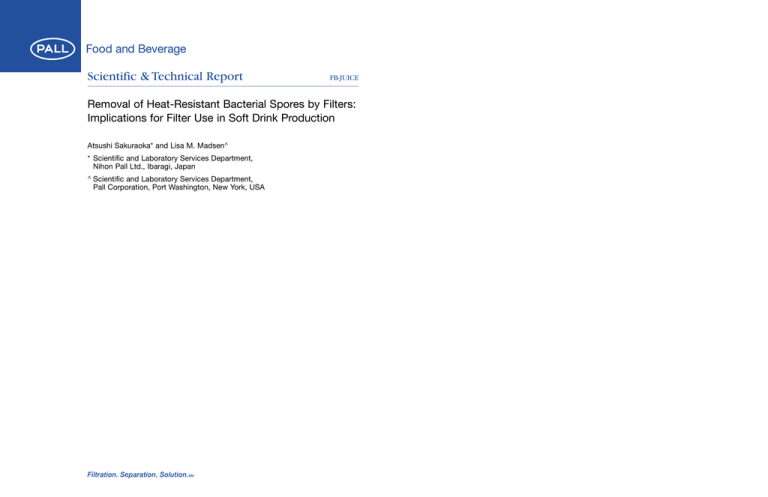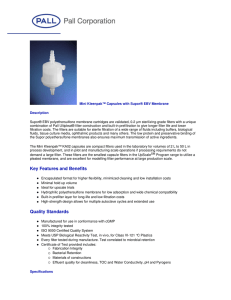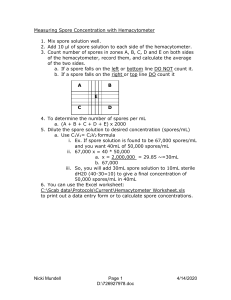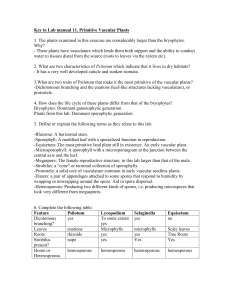Scientific & Technical Report
advertisement

Scientific & Technical Report FB-JUICE Removal of Heat-Resistant Bacterial Spores by Filters: Implications for Filter Use in Soft Drink Production Atsushi Sakuraoka* and Lisa M. Madsen^ * Scientific and Laboratory Services Department, Nihon Pall Ltd., Ibaragi, Japan ^ Scientific and Laboratory Services Department, Pall Corporation, Port Washington, New York, USA Scientific & Technical Report Removal of Heat-Resistant Bacterial Spores by Filters: Implications for Filter Use in Soft Drink Production Atsushi Sakuraoka* and Lisa M. Madsen^ * Scientific and Laboratory Services Department, Nihon Pall Ltd., Ibaragi, Japan ^ Scientific and Laboratory Services Department, Pall Corporation, Port Washington, New York, USA Abstract Soft drinks are subject to spoilage induced by acidoterrestris) were selected as test organisms bacterial spores resistant to high-temperature. because they are often isolated as spoilage bacteria To date, no effective sterilization method that in soft drinks. Spores, from each bacterial species, also does not harm the taste profile of the final were suspended in 0.067M phosphate buffer product has been developed. Filters with pore solution (pH 7.0) at concentration estimated to be sizes slightly larger than conventional 0.2µm approximately 1x10 cfu/mL. Each 1 L suspension sterilizing-grade filters were evaluated for their was filtered through a 47 mm test disk. The filtrate ability to remove heat-resistant bacterial spores. was assayed for the presence of viable spores. In addition, these filters were evaluated with an For filter membranes with absolute pore size eye on improving process parameters such as ratings of 0.45µm, no spores were detected in minimization of heat treatment on final products, the filtrate. For filters with pore size ratings of limited alteration of flavor and ingredients, and 0.65µm and 0.8µm, however, spores were energy saving and cost reduction in the soft drink detected. The study has shown that Pall manufacturing process. Spores from six filters with pore size ratings of 0.45µm are bacterial species (Bacillus subtilis, Bacillus effective in removing heat-resistant bacterial stearothermophilus, Bacillus coagulans, spores, which suggests application of these Clostridium thermaceticum, Clostridium filters for bacterial control in the soft drink thermosaccharolyticum and Alicyclobacillus manufacturing process. Non-carbonated soft drinks delivered in sealed favorable for vegetative growth. Once spores containers such as PET or glass bottles or cans are are exposed to nutrient-rich environment, usually treated by heat sterilization in the they germinate into vegetative cells and resume manufacturing process to remove spoilage propagation (Figure 1). 5 Introduction microbes. Conditions of the heat sterilization Figure 1 (far right) Life cycle of a spore forming microbe. are strict in some cases and mild in other cases, depending on the type and number of microbes in the soft drink. 1 Germinating Spore Growing Lysing Vegetative Cell Some types of microbes, that adversely impact Propagating Maturing quality of soft drinks, form spores when nutrients in the surrounding environment are depleted. Spore Forming The formed spores remain dormant until the surrounding environmental conditions are Nutrient POOR RICH 1 Spores are highly resistant to physical and thus, spores unaffected by the heat treatment Spore purification was performed at the Japan A 1000 mL aliquot of the test solution was chemical environmental factors such as heat, UV germinate and propagate. Cannners Association. First, bacterial strains introduced to each test membrane at a constant were cultured on sporulation media. The media flow rate of 33 mL/minute by means of surface was scraped with a swab to collect the peristaltic pump, and the effluent (filtrate) was bacterial strains. Bacterial strains were stored in collected in sterile glassware. Each effluent was cooled deionized water of 10 mL to 15 mL. then heated to optimum temperature (80-100°C) Fifteen-second-long ultrasonic treatment was for the induction of spore germination . After repeated on each spore solution at low spore germination was induced, the temperature Filters have been used for many years in various temperature for four to six cycles. After being was cooled to room temperature. The entire process steps of food processing plants. Microbe centrifuged, pellets were suspended in 5 mM filtrate was then filtered through the recovery control in the food processing industry by means phosphate buffer solution (pH : 8.0). Then membrane at flow rate of 33 mL/minute. When of filtration, however, is not yet commonly 100µg of lysozyme was added to each spore the filtration was completed, the recovery adopted outside the brewery and wine industries suspension of 1 mL and incubated for 15 to 30 membrane was taken off from the disk holder, Extended heat treatment is required to kill spores and in mineral water production. This is minutes at 20°C. Each suspension was examined was placed on the growth medium plate and as discussed above. Such a severe heat treatment, because sterilizing-grade filters with pore size of by phase contrast microscopy to determine if incubated however, alters taste, color, flavor and texture of 0.2/0.22µm, that have been used extensively in the spore suspension was contaminated and (50-60°C) for growth. soft drinks, which negatively affects their pharmaceutical processes for microbe removal, if the suspensions were monodispersed. The performed to determine the spore count in remove not only microbes but may also remove suspensions were frozen and sent to Pall the filtrate. essential ingredients of soft drinks. Corporation’s Scientific and Laboratory Services 2 radiation, and pH extremes (acid and alkali) . It is difficult, therefore, to completely kill them with conventional heat treatment techniques. As described above, soft drinks are often subject to spoilage induced by high-temperature resistant bacterial spores, but no effective sterilization For example, heat treatment at 121°C method that does not also degrade the flavor or is ef fective, within several seconds, to quality of the product has been developed. lower sur vival rate of vegetative cells of B. stearothermophilus to ≤1/10 . For spores 5 of B. stearothermophilus, the duration of heat treatment needs to be increased to >10-20 minutes to have the same effect. commercial value. 3 4 A new type of spoilage was reported recently in Department laboratory at Nihon Pall Ltd. 7 at the optimum temperature Colony counts were 8 The spore count in the challenge suspension was determined in the following way. Ten mL of test several cases, which was induced by the presence Filters that have pore sizes slightly larger than of heat-resistant acidophil spores in acid soft sterilizing-grade filters were investigated for their In the laboratory, 0.067M phosphate buffer solution was diluted to 10 -10 heat-resistant bacterial spore removal efficiency. (pH : 7.0) was filtrated with a DFL 0.2 µm dilutions were heated to optimum temperature thermally treated under relatively mild conditions Filtration offers multiple advantages including: membrane. To prepare the test solution, each for each spore to germinate. in order to maintain their commercial value. Such minimization of heat treatment on final products; purified spore suspension was suspended in solution was filtered with a recovery membrane, mild heat treatment, however, is not effective in limited alteration of f lavor and ingredients; 0.067M phosphate buffer to a volume of 1000 and spore count was measured after cultivation. and, energy saving and cost reduction in the mL at concentration of about 10 cfu/mL. 5 drinks such as apple juice. Acid soft drinks are killing heat-resistant acidophil spores. 6 4 9 6 fold. These Then all of each 5 The final product provides a nutrient rich environment, After the challenge test was completed, an soft drink manufacturing process. Materials and Methods Challenge Procedure integrity test was conducted again for every test All the tests were conducted in a laminar flow membrane. hood. The test membranes (EB, DB, EK and Filter membranes Challenge spores Supor® EB (EB), Fluorodyne® DB (DB), Supor® B. subtilis (IAM1026), B. stearothermophilus EK (EK) and Supor® 800 (SCW800) membranes (IAM1035), (Pall Corporation, East Hills, NY) were used C. thermosaccharolyticum as test membranes in this study. A 0.2µm SCW800), recovery membrane (DFL), 47 mm Integrity test disk holder, silicone tube and glassware were The integrity test was performed in accordance sterilized by autoclaving at 121°C for 30 minutes. with a Manual Bubble Point Test procedure. spoiled canned chicken rice), C. thermaceticum A test membrane and a recovery membrane were A silicone tube was connected to the outlet of membrane, Fluorodyne DFL (DFL), was used as (isolated from deteriorated canned milk coffee) mounted in separate disk holders, and moistened disc holders on which test membranes and recovery membrane to measure filtrate spore and A. acidoterrestris (DSM2498) were tested in with sterile water before performing an integrity recovery membranes were mounted, and the count when test membranes were challenged this study. All strains used in this study were test. Only those discs that passed the integrity other end of the tube was dipped into a beaker with spores. All membranes used in this study, provided by the Japan Canners Association. test (described below) were used in subsequent filled with water. Compressed air was introduced test steps. gradually from inlet of the disc holder, and ® were 47 mm disks. 2 B. coagulans (IAM1115), (isolated 10 from 3 Table 1 (far right) Minimum bubble point value for each filter used in this study. pressure of compressed air was recorded as a Filter membrane Minimum BP (mbar) Minimum BP (psi) DFL 3180 46 DB 1240 18 EB 1240* 18* A filter was considered acceptable when its BP EK 1100* 16* pasteurization process. One potential solution value is higher than minimum bubble point value SCW800 1100* 16* to this problem may be the application of bubble point (BP) value when bubbles started coming out from the end of silicon tube in the beaker. shown in Table 1. Table 2 shows the concentration of spores for each test membrane challenged. Table 3 shows results of the challenge tests. The results are not killed effectively in the conventional heat solely rely on bacterial-removal filters. Filter delivered raw materials (e.g. sugar solutions and juice) to reduce initial bacteria heat-resistant bacterial spores. count in manufacturing process; A number of soft drink manufacturers currently 4 5 set a goal to reduce microbe counts by ≥10 B.coagulans 3.9 x10 -1.2x10 4 11 5 cfu/mL. 4 3.0x10 C.thermaceticum 3.3x10 A.acidoterrestris 6.8x10 -4.0x10 12 cfu/mL. 4 Filter intermediates downstream of critical process steps that may allow microbes to 5 In Pall’s tests, spores were suspended 4 2) Filtration of process intermediates 5 The bio-burden level in soft drink manufacturing processes rarely exceeds 10 C.thermosaccharolyticum 1) Raw material filtration rated filters are effective in completely removing 5 4 For filtration applications, there are three options: of 0.45µm. This study shows that Pall 0.45µm 3.8x10 -2.5x10 to two lots of media. No spores of the six types B.subtilis spores to bacterial-removal filtration, and the other is to B.subtilis 1.4x10 -1.0x10 size ratings of 0.45µm. problem in the soft drink industry as they are Concentration (cfu/mL) B.stearothermophilus and DB membranes, both of which have pore available: one is to combine heat sterilization and Spore type representative of multiple challenge tests on one of bacteria were detected in filtrates from EB Heat-resistant bacterial spores cause a major microbial-control filters with pore size ratings *preliminary values Results Table 2 (far right) Concentration of spores present in each challenge Discussion penetrate and propagate. For example, filters may be considered in the extraction, 5 in test solution at concentration of 10 cfu/mL 5 penetrated the EK (pore size rating of 0.65µm) 7 preparation or aging steps,in order to suppress 2 corresponding to 10 cfu per cm of effective bacterial inclusion into the final product; surface area. In this sense, the results of the test membrane. Spores of all six bacterial species study simulate bioburden control applications in tested penetrated the SCW800 (pore size rating the soft drink industry. of 0.8µm) filters tested. 3) Final product filtration Filter final products immediately upstream of the filling step. Bacteria-removal filters have been already introduced in breweries that do not use a heat 13 These filters are mounted upstream of the filling process to remove yeast A. ac id ot er re st ris th er m ac et ic um treatment process. C . C .t he rm os ac ch ar ol yt ic um B. co ag ul an s Test Membrane B. st ea ro th er m op hi lu s Table 3 Spore Challenge Test Results B. su bt ilis Commercial Sterility‡ and Lactobacillus species. Mineral water that does not go through heat treatment is also treated with sterilizing-grade filters before DB Yes Yes NT* Yes Yes Yes EB Yes Yes Yes Yes Yes Yes EK No (LTR^) NT Yes NT NT Yes SCW800 No (LTR) No (LTR) No (TR†) No (TR) No (TR) No (LTR) being bottled. 14 Filtration to 0.45µm using the Pall rated filters noted in this study, improves biological shelf stability without exposing the soft drink flavor components to heat degradation. Visual clarity on a consistent basis is an ancillary benefit as these filters are highly effective in removing suspended particulate matter inherent in the product subcomponents, or which are a result of Few soft drink manufacturing processes, upstream process additions or reactions that however, have adopted bacterial-control filters. result in haze formation during the process. This This study, therefore, presents a novel solution to method is limited to drinks that are not intended ‡ no challenge spores recovered in the filtrate. the soft drink industry. Pall filters with pore size to be cloudy or turbid by design. * not tested. ratings of 0.45µm generally do not deteriorate ^ limited titer reduction, approximately 1-2 logs. flavor of filtrated soft drinks, and can effectively † titer reduction, approximately 4 logs. control spoilage bioburden microorganisms. This filtration process is a means to control quality, assure safety, and produce a product with full flavor character while reducing 4 When applying microbe-control filters to soft costs in processing with thermal bio-burden drink manufacturing process, two options are control methods. 5 Reference 1 2 Fujikawa, H. 1997 Mathematical Models for Thermal Death of Microorganisms, Journal of Antibacterial and Antifungal Agents Japan, 25(9): 519-534 T. Sasaki edited 1996 The methods of bioburden and environmental microorganisms in accordance with ISO standard. p. 143 Japanses Standard Association,Tokyo. 3 I. Shibasaki edited 1985 Sakkin-Jokin Ouyou Handbook p.22 Science forum Ltd.Tokyo 4 N. Matsuda, et.al 1982 Shokuhin Eiyougaki Zasshi 23: 480 5 6 D. F. Splittstoesser, D.F. Churey, J.J. Lee, C.Y. 1994 Growth Characteristics of Aciduric Sporeforming Bacilli Isolated from Fruit Juices. Journal of Food Protection 57(12): 1080 Goto, K. 2000 Thermo-Acidophilic Endospore Forming Bacteria: Genus Alicyclobacillus Journal of Antibacterial and Antifungal Agents Japan, 28(8):499-508 50 Bearfoot Road Northborough, Massachusetts 10532 7 personal communication from M. Komaki, Japan Canners Association 8 personal communication from M. Komaki, Japan Canners Association 9 personal communication from M. Komaki, Japan Canners Association 10 Integrity Testing of Sterilizing Grade Filters, Pall Ultrafine Filtration Co., publ. No.PBB-STR-28 11 N. Matsuda, et.al 1982 Shokuhin Eiyougaki Zasshi 23: 480 12 I. Shibasaki edited 1985 Sakkin-Jokin Ouyou Handbook p.22 Science forum Ltd.Tokyo 13 H. Ohya and A. Watanabe edited 1999 Shokuhin Maku Gitjutu p. 443 Korin Ltd.,Tokyo 14 H. Ohya and A. Watanabe edited 1999 Shokuhin Maku Gitjutu p. 443 Korin Ltd.,Tokyo Visit us on the Web at www.pall.com Select-A-FAX* 800.664.7255 800.345.8766 toll free 508.393.1874 fax for the latest information delivered to any fax machine, anywhere in the world. This automatic system operates 24 hours a day, seven days a week. Call 1.516.942.0523 from outside the USA. Pall Corporation has offices and plants throughout the world in locations including: Argentina, Australia, Austria, Belgium, Brazil, Canada, China, France, Germany, Hong Kong, India, Indonesia, Ireland, Italy, Japan, Korea, Malaysia, Mexico, the Netherlands, New Zealand, Norway, Poland, Puerto Rico, Russia, Singapore, South Africa, Spain, Sweden, Switzerland, Taiwan, Thailand, United Kingdom, United States, and Venezuela. Distributors are located in all major industrial areas of the world. © Copyright 2001, Pall Corporation. Pall, are trademarks of Pall Corporation. ® Indicates a Pall trademark registered in the USA. *Select-A-FAX is a registered trademark of CyberData, Inc.



